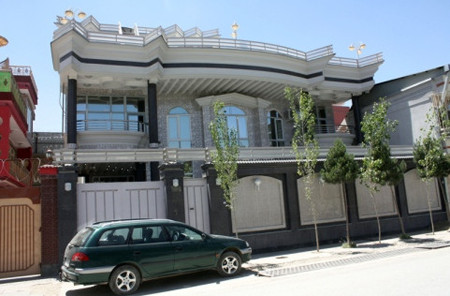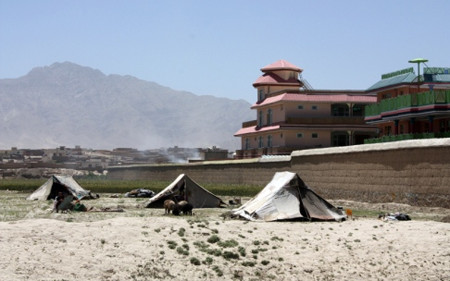By Karin Brulliard
For rent on Street 6 in the neighborhood of Sherpur: a four-story, 11-bedroom dwelling of pink granite and lime marble, complete with massage showers, a rooftop fountain and, in the basement, an Asian-themed nightclub. Price: $12,000 a month.

This Street 6 house in Kabul, Afghanistan, is available to rent for $12,000 a month. It's a four-story, 11-bedroom dwelling of pink granite and lime marble, complete with massage showers, a rooftop fountain and, in the basement, an Asian-themed nightclub. (Photo: Karin Brulliard/Washington Post
It’s a relative bargain in this district favored by former warlords and bureaucrats — Kabul’s version of Beverly Hills. There’s a war on, but carnival-colored mansions are mushrooming alongside cratered streets and sewage streams. Vast outdoor chandeliers, heated indoor pools and acres of mirrored, skyscraper glass windows abound.
The grandiose houses, derided here as narco-tecture, have become the most obvious symbols of Afghanistan’s corruption, which ranks among the world’s worst and is fueled both by an enormous influx of U.S. dollars and by the opium trade. They have paralleled a building boom sweeping this and other Afghan cities, fed by the donor money that has helped distort an economy of haves and have-nots.
But unlike the roads and schools being built, the “poppy palaces” are so garishly incongruous that some observers view them as more cultural erosion in an oft-invaded nation. Traditional Afghan residences are low-slung mud brick with internal courtyards and little external embellishment. Poppy houses, critics grumble, are imported Pakistani designs, with Arab, or simply alien, influences.
“I mix designs from the U.S. and U.K. — I create my own!” said Haji Akram Mughal, a Pakistani architect who works out of a second-story Sherpur office. On a recent day he displayed blueprints for two mansions he designed for Afghan air force generals, one of which resembled a plantation from the American South.
The United Nations says more than one-third of the Afghan population lives in “absolute poverty,” and in most of the country mud walls and no running water remain the norm. That also prevailed in Sherpur until seven years ago, when local authorities bulldozed rudimentary houses and gave the land to senior government workers. In their place now stand houses that mimic Roman ruins, the White House and a cruise ship.
Then there are the rooftop birds: Atop two domiciles sit giant statues of eagles, their wings spread.
“When I saw that eagle on my roof, I liked it more than a real one,” said Fazil Mohammed, a construction executive who owns the larger of the eagles and its 16-bedroom perch, which he said is leased to a nephew of Afghan President Hamid Karzai. Never, Mohammed said, would he have “such a fancy thing” in the typical Afghan neighborhood where he resides.
“The eagles? I can’t place them at all,” said Thalia Kennedy, an architectural historian at the Kabul-based Turquoise Mountain Foundation, which preserves historic urban areas. Poppy houses, she said, “seem to represent a massive leap from tradition.”
But not entirely. Afghanistan has always been a crossroads, Kennedy said, and some of the poppy houses hint at past eras. The Mughals, whose 16th- and 17th-century South Asian empire included parts of Afghanistan, favored glass decoration, a bit like the sparkly mosaics of some Sherpur verandas, she said.

There’s a war on, but carnival-colored mansions are mushrooming alongside cratered streets and sewage streams. The United Nations says more than one-third of the Afghan population lives in “absolute poverty,” and in most of the country mud walls and no running water remain the norm. (Photo: Karin Brulliard/Washington Post)
More Photos
An “obsession” with adorning every inch of a building’s interior is common across the Muslim world, she said, something Afghanistan’s nouveau riche have taken outside.
Zamani Nawid, a property dealer in Sherpur, said most homeowners acquire blueprints from Pakistan and hire local engineers to do the building, which is often fairly shoddy. Then they rent them to foreigners and go live in Dubai, he said. They are “very powerful people,” Nawid said — the sorts with posses of bodyguards — and so he asks no questions about their sources of funding.
Among Nawid’s listings is a 47-bedroom monstrosity that rents for $47,000 a month. He said he has also sold a property with a poolside feature that sounds like an urban legend: a mechanical contraption that looks like a black crow. It wraps its wings around swimmers, then blows air to dry them off.
“It’s bigger than a man,” Nawid, 21, said approvingly. “In Afghanistan, there is a lot of competition. So everyone wants a house that is better than the other person.”
Among this set, the popular features these days would make a fundamentalist Taliban commander keel over. For that reason, they are often concealed in the basement, said Mughal, the architect.
“Barbecue — it’s a must. Swimming pool — it’s a must. And — I feel shame — drinking,” he said about his clients’ typical demands. “Yes, a bar. Everybody likes this.”
A few blocks away, Mohammed Gul, 80, sold brooms and cucumbers outside the earth house he built with his hands three decades ago. It now stands in the shadow of Sherpur palaces, which he said he views with both awe and fear.
They are lovely, he said, even if they are “owned by drug dealers.” But the city has warned that his patch of land might soon be handed to developers. Then, said Mohammed, “the next day, they will come to us with their bulldozers.”



